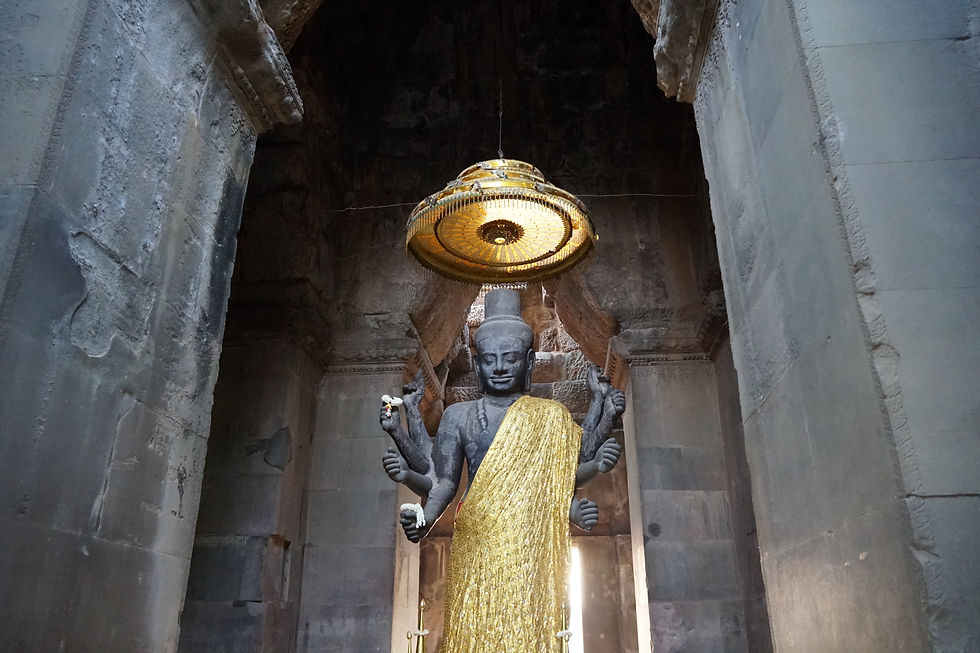Angkor Wat, and then a Heroic Return to Bangkok
- Eva Gontrum
- Jun 26, 2023
- 4 min read
Note: It has been over a month since I was supposed to have posted this, so it is going to be extremely low effort, and just a mix of thoughts and pictures. Stay tuned for my Nepal post. Between trekking in Nepal, and then traveling through to Paris, I have been LIVING, and not focused on my blog. But! The time comes again to post.



This week’s post is going to consist of picture captions with memories attached to them, rather than the typical block text blog format. Most of the camera pictures are from Angkor Wat, because I have had an unfortunate resurgence of chronic shoulder pain (spurred on from a nasty muscle spasm in my back), and I’ve been avoiding carrying anything for the last couple days. I’m not sure why I had this vision of travel making me glow like a gorgeous water buffalo, I feel more like a cockroach-monitor lizard hybrid that has dredged its’ little body up from the Bankok canals. Julia, who left this morning, deserves an enormous shout out for helping lug around all my water and sundry items all over Bangkok. Below the camera pictures I’ve included some iPhone photos, also with captions.

Angkor Wat (and other Buddhist temples), are raised to look like Mount Meru (the heavenly mountain in Hindu mythology). The opposite of Mount Meru is the demon city Lanka, which our guide told us is in Sri Lanka, although this appears to have been his own personal bias. Angkor Wat also has an intricately detailed depiction of the Ramayana carved into its inner walls, with Hanuman and his monkey head, his consort Cita, and Ravana (the king of demons).The mixture of Hinduism and Buddhism in these temples is particularly striking. Hinduism and Buddhism have different names for Naga (the seven headed snake), but both tend to use Garuda (the chimera, head of a bird and body of a lion, also a very important for Vishnu). Angkor Wat was originally a temple dedicated to Vishnu, but became a Buddhist temple by the end of the 12th century. Lakshmi, Vishnu’s consort, also appears in Angkor Wat. Apsaras (heavenly dancers) also appear everywhere, in temples that were originally Hindu but have been transformed into Buddhist temples over the years. Angkor Wat was originally filled with statues of Vishnu, many of which remain, guarding the Buddhist temple. Our guide, Briya, explained that the people here honor Hindu practices, even though 90% of Cambodia is Theravada Buddhist, their Buddhist practices often mix in Hindu mythology as well.

Staring up at Angkor Wat, thinking about how impossible it is that so many different civilizations developed the same kind of giant temple. Chichen Itza rose to its’ heights several hundred years before, and then Macchu Picchu was built a couple hundred years after Angkor Wat. The only reason we know so much about this civilization is through Sanskrit writing that was carved into the walls, a Chinese traveler from the early 12th century who recorded everything, and the French explorers who stumbled upon Angkor Wat in the midst of the jungle during their 90 year colonization of Cambodia. I didn’t realize that Vietnam, Cambodia, and Laos were all under French Colonial rule during the same period of time.

I'm also continuing to think about how in Buddhism, the 5 precepts are loving, compassion, sympathy, and equality—all worthy attributes, reasonable things to strive for.
Random Facts that I thought were interesting: In Hindu mythology, the jungle represents hell. There are also evil spirits who cannot be reincarnated into heaven or hell, and they haunt the forest. According to our guide, “There are some gods that protect the trees, but generally the trees have mixed demons and gods in them.” Ravana has many snake heads that grow back when they are chopped off, like the Hydra from Greek Mythology. In Hindu mythology, there are 32 levels of hell, and 37 levels of heaven. Every Buddha has a different animal that represents them. The current Buddha is represented by the Bull.


River of 1000 Lingas, in the driest part of the year. In the wet season, it is an rushing waterfall of holy water, blessed by the lingas before it reaches the temples. Shiva lingas are everywhere (celebration of fertility?)

The last day in Cambodia we visited the temple where our guide, Briya, had been raised as a monk. His grandmother took him to Wat Bo to be raised, because she couldn’t afford to feed him. It is apparently very common for one of the boys in each family to become a monk, because it is a way they can ensure their children can be fed, clothed, and educated. The same opportunities are not available to young girls. Only older women can become nuns.

At the Onederz hostel in Angkor Wat, we met a curious Chinese man who introduced himself by saying “Can I sit here and just listen to what you’re saying?” He proceeded to explain that he was traveling out of China for the first time. We asked him if he’d seen Angkor Wat earlier that day, and he responded by saying, “Actually, it’s not Angkor Wat that I liked most, it is Google.” He told us that he has been learning about how the Chinese Communist party is interfering and further dividing the US politically, paying for advertisements to feed racial and political tensions. His final words to us were, “Americans are in danger.” A dark moment, I suppose?
I had a glorious return to Bangkok full of clubbing on Khao San Road, trying the best shrimp pad thai of my whole Thai trip, learning what a ping pong show was (don’t ask), and taking a Thai cooking class! All around, I adore Bangkok.










Comments